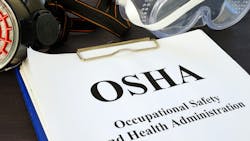What Will OSHA Look Like Under New Administration?
It’s been a long time since OSHA has come under scrutiny. “With a leadership change, often long-standing regulatory agencies will change as well,” says Phillip Russell, partner at Ogletree Deakins, a legal firm specializing in labor and employment law.
And this change could be dramatic, says Russell. “I think that you could see from Trump 47 innovation like we've never seen before.”
To understand the practical implications of that viewpoint, EHS Today spoke with Russell, who has been practicing law in the EHS space for a number of years working with companies across a range of industries.
EHS Today: What do you think will change with the new administration?
PR: OSHA has been around since 1970, and it's operated essentially the same administration to administration. It really doesn't matter who's in the White House, but I think now perhaps we will begin to see a reorganization or shift in resources away from politically popular targets.
I'll point out one in particular: the warehousing and distribution industry. I think this industry has had an inordinate amount of attention and resources focused on it. And I don’t think there is data to show that it's the most hazardous. Yet you have other industries where hazards and fatalities are occurring. One in particular is the roofing industry. It really struggles with having too high of a rate of fatalities, hospitalizations and injuries. More resources should be directed there.
So, with this new administration I hope to see a substantial shift in resources. I’m advocating for that because I think it's time that we take a fresh look at the agency, how it's organized and what its role is.
EHS Today: Do you see any particular policy changes?
PR: I think the current proposed heat standard goes away as it is now written. Right now, it’s a long document that has a lot of details and a lot of gotcha opportunities for citations, even if the employer has already done things to minimize the risk from heat. That part will go away but in its place you’ll see performance standards in which the employer has some discretion as to what to do while addressing the hazard.
As far as the walkaround rule, I'm less confident the walkaround rule is going to go away. However, there are going to be legal challenges because I think that on its face it exceeds the authority that the OSHA Act gave to OSHA as an agency. And I think that the challenges, especially following the Loper Bright decision which ended the Chevron deference earlier this year, might mean that this goes away legally. But politically speaking, I don't think it goes away, as lot of rank-and-file union members showed up big for Trump. Also, Vice President-elect JD Vance has been more open to labor unions than you might expect.
EHS Today: What type of leadership do you expect Trump to appoint and how will this affect OSHA's policymaking?
PR: I’m looking for balance and innovation. The balance is for someone to look at the agency, look at statistics and industries and say we need to make sure that we are going after what the data tells us. We need to make sure that we're pairing up resources with our focus. An example of this alignment is when OSHA issues a heat or fall protection emphasis program, yet there is no increase in resources for those programs. That's something that needs to change.
Another aspect of balance is that I think all too often OSHA looks at all employers the same without regard to the fact that some employers actually have robust programs and keep workers safe. One bad thing happens to good employers, and they are treated as those they are the worst of the worst.
That’s where we've lost balance. There is too much focus on politically popular targets. We need to focus more on the high-risk industries and the truly bad actors. OSHA needs to go back to focusing on data which shows which industries are the most hazardous to workers. That's where you move the needle. And then you can innovate to make things better.
EHS Today: Any particular steps you advise employers to take to ensure a safer workplace?
PR: All employers need to have four things in place for every single hazard in the workplace. These will saves lives and keep OSHA away:
1. Have a rule, a process or a procedure for every hazards. Whether it's fall protection, trenching, lockout/tag out, whatever it is you need to have a rule.
2. Have robust training on each of those rules. Make sure that everyone who is going to be working around, near or exposed to a hazard in any way goes through training about that process or procedure to avoid the hazard.
3. Have a compliance program and be certain that employees are following the rules and their training.
4. Maintain discipline around these process. Enforcement is key. What do you do to enforce the rules if they're not being followed? Are people being put in harm's way?
These four things are the elements of the unavoidable employee misconduct defense. What it really asks is did an employer do all they could do to avoid tragedy? If you do these four things, I guarantee that you will have a safer place to work, and you will save lives.
About the Author
Adrienne Selko
Senior Editor
Email [email protected]
Adrienne Selko is also the senior editor at Material Handling and Logistics and is a former editor of IndustryWeek.


